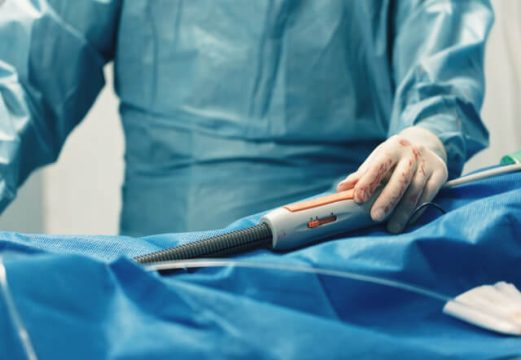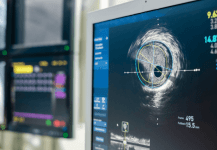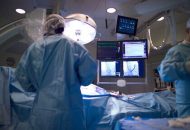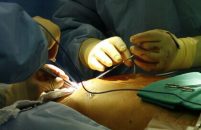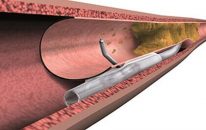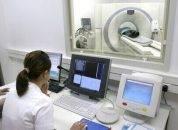Assessing intermediate coronary lesions with intracoronary physiology tests such as fractional flow reserve (FFR) or other non-hyperemic indices is considered the standard of care by both American and European societies. Likewise, intravascular imaging techniques (IVI), be it IVUS or optical coherence tomography (OCT), are of great use in assessing and guiding complex coronary lesions and…
Network Meta-Analysis of Complementary Imaging (IVUS/OCT + Conventional Angiography) for Coronary Stenting
Complementary imaging allows for the identification of numerous scenarios not visible with conventional angiography (ICA), both for the assessment of differential diagnoses and the improvement of percutaneous coronary intervention (PCI) outcomes. Advantages include assessment of plaque characteristics, vessel plaque burden, stent edge dissection, vessel diameter, and correct apposition, among others. While intravascular ultrasound (IVUS) was…
Use of Intravascular Lithotripsy in Left Main
The Left main coronary artery supplies circulation to roughly 70% of myocardium, and left main disease requires a high risk intervention with significant impact on patient prognosis. The current guidelines have set the threshold for intervention in LM disease at ≥50% stenosis, irrespective of the presence of symptoms or ischemic burden. LM calcification is an…
Sub-Analysis of the REVIVED-BCIS2: Myocardial Viability Changes Prognosis in Ischemic Cardiomyopathy Revascularization?
The purpose of myocardial viability testing is to identify patients that might benefit from revascularization by diagnosing three types of myocardium: normal, viable or hibernating, and scarred (non-viable). Non-randomized studies have shown recovery of a viable ventricle after myocardial revascularization surgery (CABG) and improved survival. However, a sub-analysis of the main study on viability testing,…
Preparation Before Elective Coronary Angiography: Is Prolonged Fasting the Only Option?
When scheduling a coronary angiography, patients are usually instructed to fast for at least 8 hours (no oral intake after dinner). However, this strategy can lead to negative effects such as discomfort, irritability, dehydration, and even hypoglycemia in some cases. Previous studies have not shown significant differences in gastric complications between patients fasting only 2 hours before…
Contemporary Outcomes of CTO PCI in Europe: The ERCTO Registry
Roughly 20% or coronary angiographies show some form of chronic total occlusion (CTO), and this figure is twice as high for diabetic patients or those with cardiac failure and reduced ejection fraction (EF). CTO percutaneous intervention (PCI) has experienced a significant growth thanks to the development of new techniques and dedicated material. However, a considerable…
Events According to Revascularization Modality in the ISCHEMIA Trial
The main studies carried out on patients with chronic coronary syndromes (CCS), such as the MASS II, COURAGE, BARI 2D and FAME-2, failed to show benefits in terms of mortality with the invasive approach. The ISCHEMIA, a large randomized study including patients with moderate to severe ischemia, with without left main disease and with acceptable…
Complex Coronary Angioplasty in Elderly Patients: Problem or Solution?
Cardiovascular disease is the leading cause of death in elderly adults (individuals aged 75 years or older). In turn, coronary heart disease is one of the main causes of morbidity in this population. In addition to anatomical complexities, there are other factors that may complicate its management, such as polypharmacy, frailty, and procedure-related risks. All of…
Cardiac Angiography: Necessary for CABG Patient Diagnosis?
Cardiac revascularization surgery (CABG) has shown positive results at long term in CAD patients with multivessel or left main disease. However, we are well aware that, after CABG, there might be native disease progression over time. Also, at followup, we often see high incidence of venous graft failure. According to registry data, approximately 1 in…
ISCHEMIA Trial: Does Complete Anatomical or Functional Revascularization Modify Anything Compared with Medical Treatment?
Chronic coronary syndrome (CCS) has been considered another comorbidity in previous studies, and there has been no significant reduction in cardiovascular mortality or myocardial infarction (MI) rates with revascularization through percutaneous coronary intervention (PCI) or myocardial revascularization surgery (MRS) compared with optimal medical treatment (OMT). One possible reason for the lack of benefit has been…
MACT Study: Monotherapy with P2Y12 Inhibitor Associated with Colchicine after Acute Coronary Syndrome
Dual antiplatelet therapy (DAPT) is the current standard for preventing thrombotic events in high-risk patients with coronary artery disease, as well as in patients with acute coronary syndrome (ACS) undergoing percutaneous coronary intervention (PCI). However, this approach increases the risk of bleeding. To reduce this risk, there have been studies that discontinued the use of…
